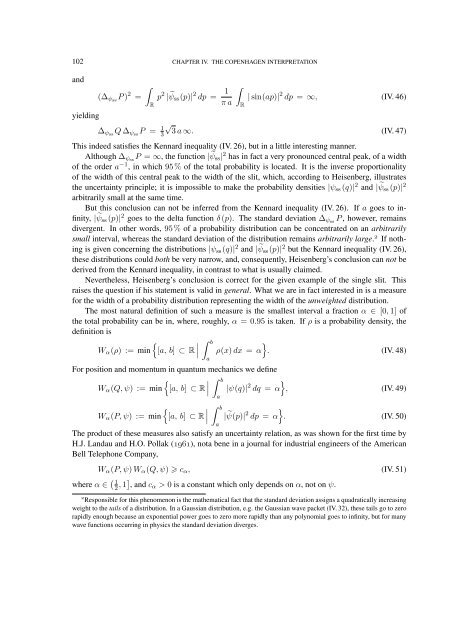FOUNDATIONS OF QUANTUM MECHANICS
FOUNDATIONS OF QUANTUM MECHANICS
FOUNDATIONS OF QUANTUM MECHANICS
You also want an ePaper? Increase the reach of your titles
YUMPU automatically turns print PDFs into web optimized ePapers that Google loves.
102 CHAPTER IV. THE COPENHAGEN INTERPRETATION<br />
and<br />
yielding<br />
(∆ ψss P ) 2 =<br />
∫<br />
R<br />
p 2 | ˜ψ ss (p)| 2 dp = 1<br />
π a<br />
∫<br />
R<br />
| sin(ap)| 2 dp = ∞, (IV. 46)<br />
∆ ψss Q ∆ ψss P = 1 3√<br />
3 a ∞. (IV. 47)<br />
This indeed satisfies the Kennard inequality (IV. 26), but in a little interesting manner.<br />
Although ∆ ψss P = ∞, the function | ˜ψ ss | 2 has in fact a very pronounced central peak, of a width<br />
of the order a −1 , in which 95% of the total probability is located. It is the inverse proportionality<br />
of the width of this central peak to the width of the slit, which, according to Heisenberg, illustrates<br />
the uncertainty principle; it is impossible to make the probability densities |ψ ss (q)| 2 and | ˜ψ ss (p)| 2<br />
arbitrarily small at the same time.<br />
But this conclusion can not be inferred from the Kennard inequality (IV. 26). If a goes to infinity,<br />
| ˜ψ ss (p)| 2 goes to the delta function δ (p). The standard deviation ∆ ψss P , however, remains<br />
divergent. In other words, 95% of a probability distribution can be concentrated on an arbitrarily<br />
small interval, whereas the standard deviation of the distribution remains arbitrarily large. 2 If nothing<br />
is given concerning the distributions |ψ ss (q)| 2 and | ˜ψ ss (p)| 2 but the Kennard inequality (IV. 26),<br />
these distributions could both be very narrow, and, consequently, Heisenberg’s conclusion can not be<br />
derived from the Kennard inequality, in contrast to what is usually claimed.<br />
Nevertheless, Heisenberg’s conclusion is correct for the given example of the single slit. This<br />
raises the question if his statement is valid in general. What we are in fact interested in is a measure<br />
for the width of a probability distribution representing the width of the unweighted distribution.<br />
The most natural definition of such a measure is the smallest interval a fraction α ∈ [0, 1] of<br />
the total probability can be in, where, roughly, α = 0.95 is taken. If ρ is a probability density, the<br />
definition is<br />
{<br />
∫ b<br />
}<br />
W α (ρ) := min [a, b] ⊂ R ∣ ρ(x) dx = α . (IV. 48)<br />
a<br />
For position and momentum in quantum mechanics we define<br />
{<br />
∫ b<br />
}<br />
W α (Q, ψ) := min [a, b] ⊂ R ∣ |ψ(q)| 2 dq = α , (IV. 49)<br />
{<br />
W α (P, ψ) := min [a, b] ⊂ R<br />
∣<br />
a<br />
∫ b<br />
a<br />
| ˜ψ(p)|<br />
}<br />
2 dp = α . (IV. 50)<br />
The product of these measures also satisfy an uncertainty relation, as was shown for the first time by<br />
H.J. Landau and H.O. Pollak (1961), nota bene in a journal for industrial engineers of the American<br />
Bell Telephone Company,<br />
W α (P, ψ) W α (Q, ψ) c α , (IV. 51)<br />
where α ∈ ( 1<br />
2 , 1] , and c α > 0 is a constant which only depends on α, not on ψ.<br />
2 Responsible for this phenomenon is the mathematical fact that the standard deviation assigns a quadratically increasing<br />
weight to the tails of a distribution. In a Gaussian distribution, e.g. the Gaussian wave packet (IV. 32), these tails go to zero<br />
rapidly enough because an exponential power goes to zero more rapidly than any polynomial goes to infinity, but for many<br />
wave functions occurring in physics the standard deviation diverges.
















